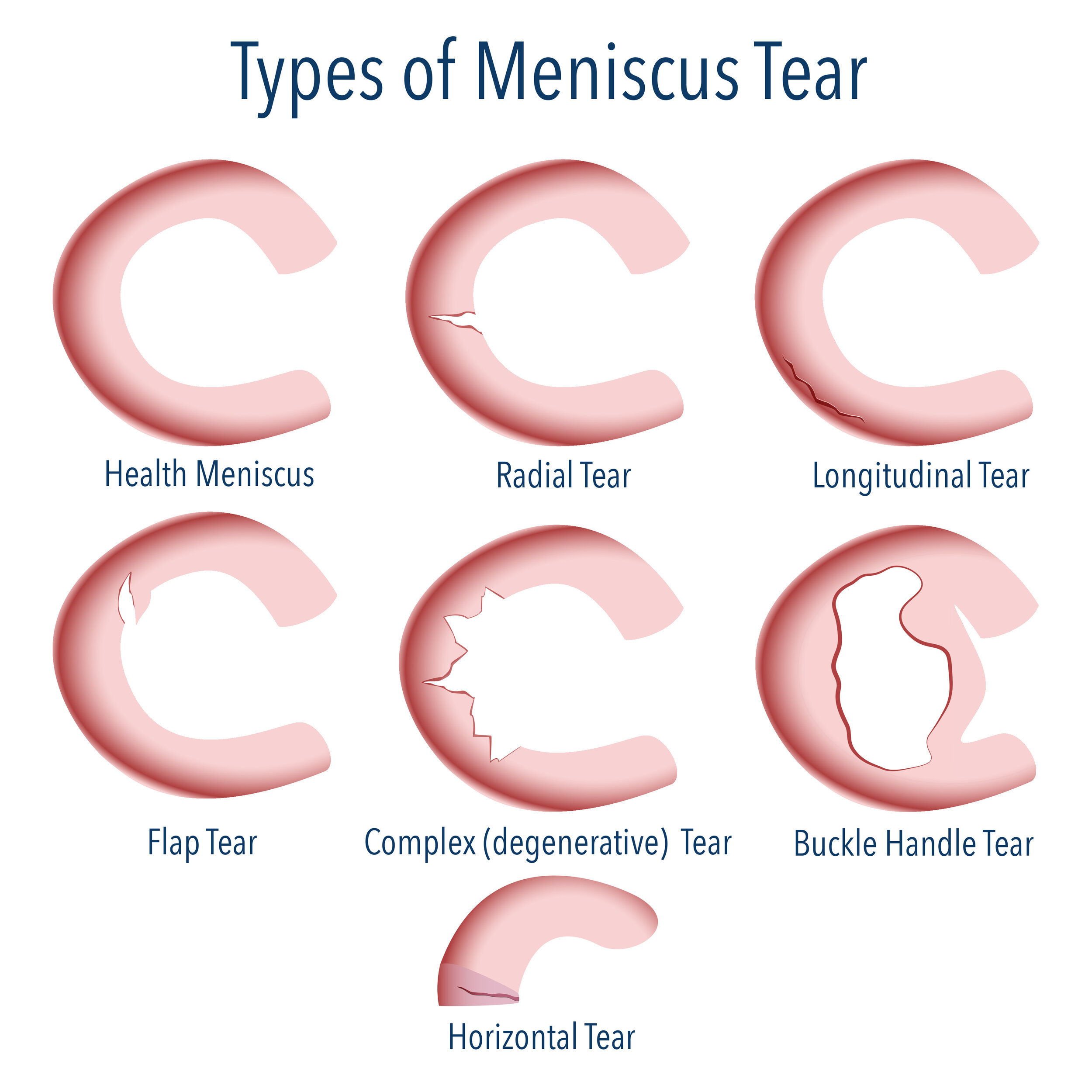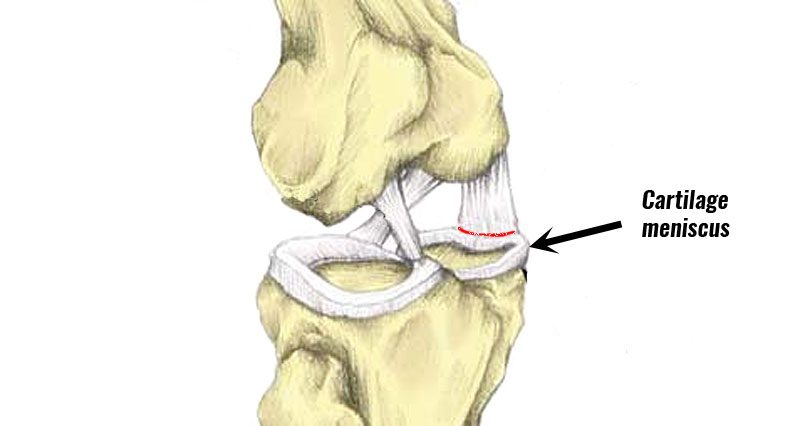Meniscus Tear Anatomy and Physiology

The meniscus is a C-shaped piece of cartilage that acts as a shock absorber and stabilizer in the knee joint. Understanding its anatomy and physiology is crucial for comprehending the nature of meniscus tears and their implications.
Structure and Function of the Meniscus
The meniscus is located between the femur (thighbone) and tibia (shinbone) in the knee joint. It plays a critical role in distributing weight evenly across the joint, absorbing impact forces, and providing stability during movement. The meniscus consists of two parts: the medial meniscus, on the inner side of the knee, and the lateral meniscus, on the outer side.
Types of Meniscus Tears
Meniscus tears can occur in various ways, depending on the force and direction of the injury. Some common types of meniscus tears include:
- Horizontal Tear: This type of tear occurs across the width of the meniscus, often resulting from a twisting or shearing force.
- Vertical Tear: This tear runs along the length of the meniscus, often caused by a direct blow to the knee or a sudden twisting motion.
- Bucket-Handle Tear: A large, vertical tear that detaches a significant portion of the meniscus, resembling a bucket handle. This tear can cause significant instability and pain.
- Radial Tear: A tear that extends from the outer edge of the meniscus toward the center, resembling spokes on a wheel.
Blood Supply to the Meniscus, Meniscus tear
The blood supply to the meniscus is limited, primarily concentrated in the outer portion (peripheral zone). The inner portion (inner zone) receives very little blood supply. This difference in blood supply has significant implications for healing.
Tears in the outer zone of the meniscus have a better chance of healing naturally, as they have a more robust blood supply. However, tears in the inner zone, which have limited blood flow, are less likely to heal on their own and may require surgical intervention.
Causes and Risk Factors of Meniscus Tears

The meniscus, a C-shaped piece of cartilage in the knee, acts as a shock absorber and helps stabilize the joint. A meniscus tear occurs when this cartilage is torn, often due to a sudden injury or gradual wear and tear. Understanding the causes and risk factors associated with meniscus tears can help individuals take preventive measures and seek appropriate treatment if needed.
Common Causes of Meniscus Tears
Meniscus tears are frequently caused by a combination of factors, including:
- Sports Injuries: Activities involving twisting, pivoting, or sudden changes in direction, such as football, basketball, soccer, and skiing, often lead to meniscus tears. These activities put stress on the knee joint, making it susceptible to injury.
- Degenerative Changes: As we age, the meniscus naturally deteriorates due to wear and tear. This process, known as osteoarthritis, can weaken the cartilage, making it more prone to tearing, especially with minor trauma.
- Direct Impact: A direct blow to the knee, such as a fall or a car accident, can also cause a meniscus tear.
- Previous Injuries: Individuals who have previously sustained a knee injury, such as a ligament tear or fracture, are at increased risk of developing a meniscus tear.
Risk Factors for Meniscus Tears
Certain factors increase an individual’s susceptibility to meniscus tears. These include:
- Age: Meniscus tears are more common in older adults due to the natural degeneration of cartilage with age.
- Activity Level: Individuals who participate in high-impact activities, especially those involving twisting and pivoting motions, have a higher risk of meniscus tears.
- Genetics: Some individuals may have a genetic predisposition to weaker cartilage, making them more prone to meniscus tears.
- Obesity: Excess weight puts extra stress on the knee joint, increasing the risk of meniscus tears.
Risk Factors for Different Types of Meniscus Tears
The risk factors for different types of meniscus tears can vary. For example,
- Horizontal tears are often associated with degenerative changes, while vertical tears are more likely to occur due to acute injuries.
- Bucket-handle tears, which involve a large flap of torn meniscus, are commonly caused by direct impact or twisting injuries.
- Radial tears, characterized by a radial pattern of tears, are frequently seen in athletes who engage in repetitive twisting movements.
Symptoms and Diagnosis of Meniscus Tears

A meniscus tear can cause a variety of symptoms, ranging from mild to severe. The severity of the symptoms depends on the size and location of the tear. Some people may not experience any symptoms at all, while others may have significant pain and difficulty walking.
The diagnosis of a meniscus tear typically involves a physical exam and imaging studies. Your doctor will ask you about your symptoms and medical history, and they will perform a physical exam to assess your range of motion, stability, and tenderness. They may also perform special tests to evaluate the integrity of your meniscus.
Diagnosis of a Meniscus Tear
A doctor will diagnose a meniscus tear based on your symptoms, physical exam, and imaging studies.
- Physical Exam: During a physical exam, your doctor will assess your range of motion, stability, and tenderness in your knee. They may also perform special tests to evaluate the integrity of your meniscus. For example, they may perform the McMurray test, which involves rotating your knee and listening for a click or pop. This test can help to identify a torn meniscus.
- Imaging Studies: If your doctor suspects a meniscus tear, they may order imaging studies, such as an MRI or X-ray. An MRI is the most sensitive test for diagnosing a meniscus tear. It can provide detailed images of the meniscus and surrounding structures. X-rays are less sensitive for diagnosing a meniscus tear, but they can help to rule out other conditions, such as a fracture.
Symptoms of a Meniscus Tear
The symptoms of a meniscus tear can vary depending on the severity of the tear. Some people may not experience any symptoms at all, while others may have significant pain and difficulty walking.
- Pain: Pain is a common symptom of a meniscus tear. The pain may be sharp and sudden, or it may be a dull ache that worsens with activity. The pain is often located in the inner or outer part of the knee, and it may radiate down the leg.
- Swelling: Swelling is another common symptom of a meniscus tear. The swelling may develop immediately after the injury, or it may take a few days to appear.
- Locking: A torn meniscus can cause the knee to lock or catch. This happens when a piece of the torn meniscus gets trapped between the bones of the knee.
- Stiffness: A torn meniscus can also cause stiffness in the knee. The stiffness may make it difficult to bend or straighten the knee.
- Giving way: A torn meniscus can cause the knee to give way or buckle. This happens when the meniscus is no longer able to support the knee joint.
- Popping or clicking: Some people with a torn meniscus may hear a popping or clicking sound in their knee when they bend or straighten it.
Common Symptoms of Different Types of Meniscus Tears
| Type of Meniscus Tear | Common Symptoms |
|---|---|
| Horizontal Tear | Pain, swelling, locking, giving way, popping or clicking |
| Vertical Tear | Pain, swelling, stiffness, giving way |
| Bucket-Handle Tear | Pain, swelling, locking, giving way, popping or clicking |
| Degenerative Tear | Pain, swelling, stiffness, giving way |
